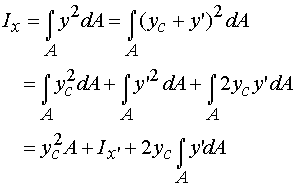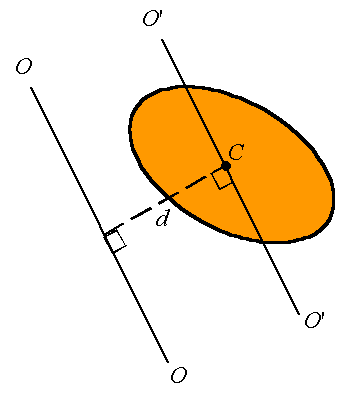Area Moment of inertia
The area moment of inertia is the second
moment of area around a given axis. For example, given the axis O-O and
the shaded area shown, one calculates the second moment of the area by adding
together ![]() for all the
elements of area dA in the shaded area.
for all the
elements of area dA in the shaded area. 
The area moment of
inertia, denoted by I, can, therefore, be calculated from

If we have a rectangular coordinate system as
shown, one can define the area moment of inertial
around the x-axis, denoted by Ix, and
the area moment of inertia about the y-axis,
denoted by Iy. These are
given by


The polar area
moment of inertia, denoted by JO, is the area moment
of inertia about the z-axis given by

Note that since ![]() one has the relation
one has the relation
![]()
The radius of
gyration is the distance k away from the axis that all the area
can be concentrated to result in the same moment of inertia. That is,
![]()
For a given area, one can define the radius
of gyration around the x-axis, denoted by kx,
the radius of gyration around the y-axis, denoted by ky, and the radius of gyration
around the z-axis, denoted by kO.
These are calculated from the relations




It can easily to show from ![]() that
that
![]()
The parallel axis
theorem is a relation between the moment of inertia about an axis
passing through the centroid and the moment of
inertia about any parallel axis.

Note that from the picture we have

Since  gives the distance of the centroid
above the x'-axis, and since the this distance is zero, one must
conclude that the integral in the last term is zero so that the parallel axis
theorem states that
gives the distance of the centroid
above the x'-axis, and since the this distance is zero, one must
conclude that the integral in the last term is zero so that the parallel axis
theorem states that
![]()
where x' must pass through the centroid of
the area. In this same way, one can show that
![]()

In general, one can use the parallel axis
theorem for any two parallel axes as long as one passes through the centroid. As shown in the picture, this is written as
![]()

where ![]() is the moment of inertia about the axis O'-O'
passing through the centroid, I is the
moment of inertia about the axis O-O, and d is the perpendicular
distance between the two parallel axis.
is the moment of inertia about the axis O'-O'
passing through the centroid, I is the
moment of inertia about the axis O-O, and d is the perpendicular
distance between the two parallel axis.
The moment of inertia of composite bodies can be calculated by adding together
the moment of inertial of each of its sections. The only thing to remember is
that all moments of inertia must be evaluated bout the same axis. Therefore,
for example,


To calculate the area moment of inertia of
the composite body constructed of the three segments shown, one evaluates the
moment of inertial of each part about the x-axis and adds the three
together.